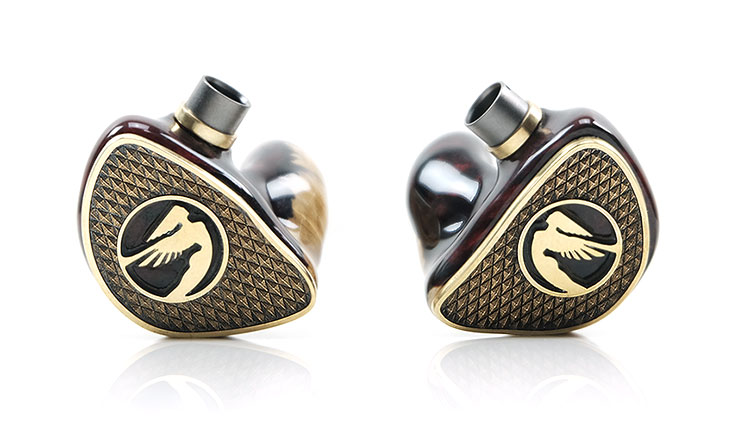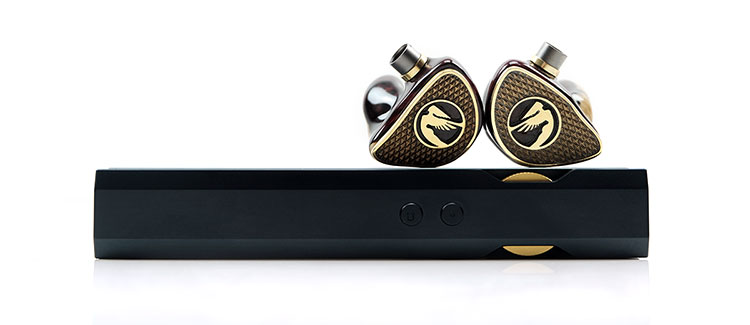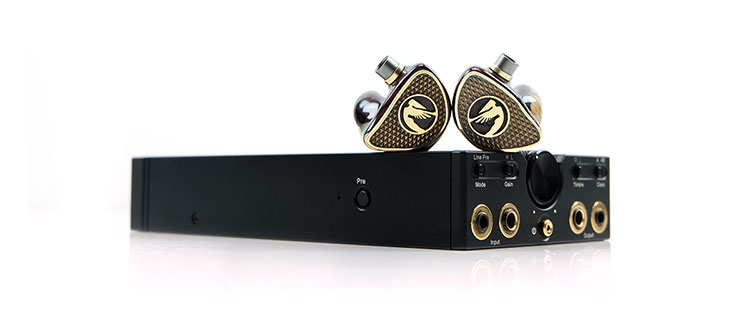Sound Impressions
Summary
Jolene is a thunderous richly textured and very powerful sound signature. Granted, its bass module can vary that opening gambit quite considerably, but overall, the tone is both smooth and natural with some fantastic bass and mids body from those four dynamic drivers right up to its max bass setting.
It is not a huge break from Layla’s tone but rather changes some technical aspects compared to what Layla brought to the table. Particularly, in terms of staging space with excellent levels of depth and improved stereo imaging. That power, therefore, does not come at the cost of instrumental separation or a diminished vocal presence.
For me, that also means I can crank up that bass module and still get some proper control over the dual dynamic driver low-frequency performance, something I was more cautious about on the older Layla/Bass module performance.
Response
In terms of FR, the Jolene has more of a sub-bass bias and less of a focused mid-bass hump and by that I mean it peaks around 60-70Hz before it takes a graceful linear drop through the mid and upper mid-bass with a low point somewhere around 400-500Hz.
I do tend to prefer my bass tuned in that manner with good separation. This is also a major factor for Jolene’s superb control on potentially excessive bass bleed creeping into the mids.
From there, the curve is on a rise through the lower-mids as the dual 4.9mm drivers take over bandwidth duties peaking around 1k. That means lower-pitched instruments and male vocals have an excellent presence and solidity to go with that low-end power.
Beyond, the Jolene is more on the relaxed and smooth side with a slow fade from around 6k to 10k but with an all-important bump around 12k for headroom. You also get a few secondary bumps in the upper mids and lower treble from 3-5k that allow higher-pitching vocals and percussion to resonate clearly.
Timbre
The timbral emphasis is very much on the smooth and natural side with a smattering of treble energy in the upper mids for percussion accuracy.
From the low end to the mids, it’s all about those dynamic drivers and the beautiful texture they can tease out. This is a timbre that is voluptuous, dense, and physical but also lacking in heavy bloom and annoying smear.
Here I do encourage you to pick a source that teases out a high level of resolution to add some character to the broad note texture created by the Jolene on the lows and mids.
It makes a huge difference if, for example, you pair the Jolene with the Luxury & Precision P6 R2R DAP or the Hifiman R2R2000 multi-bit PCM1704K Black edition which do exceedingly well with note micro-detail.
And is not just about fleshing out big moment events from gut-wrenching kick drum strikes but also the way underlying instrumental sustain richness also comes to the fore.
That rising lower-mids curve and the smaller dynamic driver’s performance create a very natural albeit slightly even-harmonic timbre that adds some emphasis to bass guitar plucks and rhythm guitar chords.
Aspects like this will mark out the Jolene as a very satisfying listening experience for those who love their hard rock and 80s classics.
Vocal Timbre
Vocals have some fantastic weight, particularly alternative female breathy vocals with a lot of natural decay. They do not sound as pristine or as speedy as something like the Empire Ears Odin’s BA wall of detail. Instead, they are a bit more planted, and full-bodied, and deliver a palpable analog tone to their timbre.
Check out Julia Jacklin’s “Body” lead track from her 2019 Crushing album as a good example of that analog style of presentation and where Jolene draws you into a track.
Jolene’s harmonic balance will always draw you to the fundamental and second order rather than push you upwards. That means you will be hard-pressed not to hear immediately that underlying bass guitar rhythm and those rounded piano notes string strikes supporting Julia’s soft vibrato and sweet-toned vocal performance. It is warm and inviting rather than cold and clinical.
Staging
Jolene is all about depth and width with excellent stereo imagery. I think JH Audio has done an excellent job cranking out the sub-bass extension and rumble from Jolene’s dual dynamic drivers without letting it bleed all over the upper-bass and smearing into the mids.
Towards the top end, it is a little more relaxed and not as sparkling as some of the competition with a drop in presence around 6-9k taking a little air away. For me, that’s the classic JH Audio sound and not a million miles away from the Layla response curve except for a more forward upper-midrange and treble energy.
The bump in the upper mids and lower treble combined with the more articulate BA for the highs add some welcome clarity to percussion runs but not to the point where it upsets the harmonic balance so it’s still a fairly liquid attack and plenty of body on cymbals and hi-hats.
Vocals around 1-2k have a relatively forward presence as do instruments hitting 500Hz-1k where those two manifold 4.9mm dynamic drivers take over.
Bass Adjustments
The attenuator module on the stock 7-pin cable seems more transformative than the older cable with a dB attenuation a bit more radical than the original.
It does seem to target the two 9.2mm dynamic drivers a bit more up to the 400Hz crossover compared to the rest of the range so when you drop to zero or go to max the most fundamental changes are going to be felt there.
Bass Adjustment ‘Zero’
On the Layla, this was still a fairly juicy setting but the most balanced on the old module so consequently the one I enjoyed the most. It is quite the opposite on the Jolene and it may well be because of how integral the bigger dynamic drivers are to the overall performance.
The sound is a little too flat for my tastes and you will notice a distinct loss in depth becoming very mid-centric in terms of staging. You will also find yourself pushing up the volume a little bit more compared to the max setting considering the bass takes something like a 15dB hit.
Vocals take more of a center stage which is a bonus and the mids dynamic driver does retain a lot of that yummy texture and smoothness so their timbre barely changes. I would pick this setting if I needed something a bit more intimate or vocal-orientated and did not need a driving rhythm section behind them.
Bass Adjustment ‘2-3 pm’
I would say this is the best balance between flat and all-out bass and is similar in weight to the original zero setting on the older Layla stock cable module from 2018.
My personal preference is closer to 3 pm than 2 pm, something just clicks going up that extra notch for me with sub-bass suddenly becoming a lot more distinguishable and weighted in its delivery.
The overall effect is to add some substantial depth and power to the sound signature without it becoming dominant. The coloration is a little gentler than the max setting and perfect for allowing your typical mixed voice rock vocals and guitar solo riffs to take center stage.
Bass Adjustment ‘Max’
Maxing out the bass is an outrageous setting but also my secret guilty pleasure. I use this adjustment a lot more than I did on the Layla and for good reason.
The control is a lot better this time around and with a curve that doesn’t exaggerate the mid-bass warmth and presence too much. The Jolene seems to be able to keep an admirable lid on the bloom and still create enough space for the mids to breathe.
Nevertheless, it does start to veer towards more of an L-shaped response curve so the power and sub-bass presence is very much to the fore with this setting. Timbral bias will pull you to the bottom order of the notes including vocals and percussion.
This is a weighty signature but a very fun sound designed to be cranked out. Just watch you dip the volume a little compared to the ‘quieter’ zero setting.
Synergy
Efficiency
The Jolene is rated at 10Ω and 114dB which on paper seems fairly easy to drive and in truth low-gain on most decent DAPs and portable amps will be just fine.
However, I did find it required a bit more juice than some of the competition such as the Odin which is rated at 3Ω and 108dB, and the Layla rated at 20Ω and 117dB SPL. It is not the hardest of our compared monitors to drive being more sensitive than the Elysium which is rated at 16.4Ω and 105dB SPL.
One interesting aspect is how the bass module affects your sensitivity to loudness levels. The Jolene is strongest in terms of dB south of 400Hz where those dual 9.2mm dynamic drivers reside so the more bass you cut out, (effectively dropping to zero on the module), the more power you take out of the Jolene’s FR.
This in turn creates a stronger perception of a loss of volume or dynamic range which teases you to up the volume on any source to compensate. Once you start ramping up the bass module to around 2-3 pm onwards the dB amplitude goes up and the volume starts coming down as a result.
Since this sample uses an SE 7-pin stock cable I can only test it unbalanced from our selected DAPs for this review. All DAPs delivered a very black background with the 3.5mm TRS connection.
I have a feeling that going 2.5mm TRRS will give pretty strong results on high noise floors also since it is a little less sensitive than the Odin which did quite well in our ‘hiss’ tests.
Pairings
The JH Audio Jolene was tested with the following DAPs and portable amps: iBasso D220 MAX, LP P6, Hifiman R2R2000 (black), FiiO M15, HiBy R8, Lotoo PAW Gold Touch, and the Cayin C9 portable tube amplifier.
R2R Texture
Out of those, I gravitated primarily to the multi-bit PCM1704k and R2R performances from the R2R2000 and the LP P6, followed by C9. The LP P6 stood out among the crowd because of the way it resolved the texture from Jolene’s dynamic drivers which was simply superb.
The P6 has this wonderful ability to flesh out the rich texture in notes with a tremendous amount of detail and still offers a very natural almost analog-type performance with world-class instrumental separation.
The Jolene takes to that like a duck takes to water with its low-end and midrange dynamic driver sounding wonderfully detailed, vivid, and natural in their performances.
Multi-Bit Staging
The R2R2000 goes about its business with Jolene in a slightly different manner with a more neutral sounding signature but what I love most about this pairing is the dynamic range and sheer size of the staging capability this pairing can deliver.
The treble is clean and extended and the bass is deep and powerful at the same time with a very spacious and open sound. Because Jolene is relatively relaxed on the top-end it does not sound too pushed or harsh either, with the R2R2000 acting almost like a brighter counterweight for harmonic balance.
Amping Headroom
The Cayin C9 comes in with its dynamic prowess, particularly on the low end when using the tube timbre and its Class AB setting. I do advise pairing with a decent source such as the Lotoo PAW Gold Touch to ensure you get a decent level of resolution into the C9.
I felt the Jolene scaled quite well with the power of the C9 with wide stereo imaging on a very black background and plenty of space for those dynamic drivers to flex their muscles without the performance ever feeling congested.
Neutral Over Warm
DAPs with a neutral sound signature and excellent separation and clarity fared better for me than warmer DAPs when paired with the Jolene.
The DX220 MAX was the best of the rest so to speak with a very balanced linear sound signature and an engaging yet spacious sounding midrange performance.
The FiiO M15 also offered a cleaner tone but tended to just drop back a bit too much for me in the mids which is something I like to tease out as much as I can with the Jolene. The HiBy R8 was quite open-sounding with some excellent and very sweet-sounding vocal timbre, particularly for high-pitched female vocals.
Click on page 3 below for select comparisons and the final verdict.








